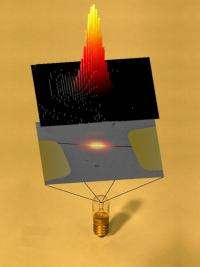World's smallest incandescent (nano)lamp with carbon nanotube filament

(PhysOrg.com) -- In an effort to explore the boundary between thermodynamics and quantum mechanics -- two fundamental yet seemingly incompatible theories of physics -- a team from the UCLA Department of Physics and Astronomy has created the world's smallest incandescent lamp.
The team, which is led by Chris Regan, a member of the California NanoSystems Institute at UCLA, and includes Yuwei Fan, Scott Singer and Ray Bergstrom, has published the results of their research May 5 in the online edition of the journal Physical Review Letters.
Thermodynamics, the crown jewel of 19th-century physics, concerns systems with many particles. Quantum mechanics, developed in the 20th century, works best when applied to just a few. The UCLA team is using their tiny lamp to study physicist Max Planck's black-body radiation law, which was derived in 1900 using principles now understood to be native to both theories.
The incandescent lamp utilizes a filament made from a single carbon nanotube that is only 100 atoms wide. To the unaided eye, the filament is completely invisible when the lamp is off, but it appears as tiny point of light when the lamp is turned on. Even with the best optical microscope, it is only just possible to resolve the nanotube's non-zero length. To image the filament's true structure the team uses an electron microscope capable of atomic resolution.
With less than 20 million atoms, the nanotube filament is both large enough to apply the statistical assumptions of thermodynamics and small enough to be considered as a molecular — that is, quantum mechanical — system.
"Because both the topic (black-body radiation) and the size scale (nano) are on the boundary between the two theories, we think this is a very promising system to explore," Regan said. "The carbon nanotube that is used as the lamp filament is ideal for their purposes because of its smallness and extraordinary temperature stability."
Carbon nanotubes were only discovered in 1991, but using carbon in a light bulb is not a new idea. Thomas Edison's original light bulbs used carbon filaments. The UCLA research team's light bulb is very similar to Edison's, except that their filament is 100,000 times narrower and 10,000 times shorter, for a total volume only one one-hundred-trillionth that of Edison's.
Provided by University of California - Los Angeles


















